Computer Networks (CS425)
Instructor: Dr. Dheeraj Sanghi
IEEE 802.5: Token Ring Network
- Token Ring is formed by the nodes connected in ring format as shown
in the diagram below. The principle used in the token ring network is
that a token is circulating in the ring and whichever node grabs that
token will have right to transmit the data.
- Whenever a station wants to transmit a frame it inverts a
single bit of the 3-byte token which instantaneously changes it into a
normal data packet. Because there is only one token, there can atmost be
one transmission at a time.
- Since the token rotates in the ring it is guarenteed that
every node gets the token with in some specified time. So there is an
upper bound on the time of waiting to grab the token so that starvation
is avoided.
- There is also an upper limit of 250 on the number of nodes in the network.
- To distinguish the normal data packets from token (control
packet) a special sequence is assigned to the token packet. When any
node gets the token it first sends the data it wants to send, then
recirculates the token.

If a node transmits the token and nobody wants to send the data the
token comes back to the sender. If the first bit of the token reaches
the sender before the transmission of the last bit, then error situation
araises. So to avoid this we should have:
propogation delay + transmission of n-bits (1-bit delay in each node ) > transmission of the token time
A station may hold the token for the token-holding time. which is 10 ms
unless the installation sets a different value. If there is enough time
left after the first frame has been transmitted to send more frames,
then these frames may be sent as well. After all pending frames have
been transmitted or the transmission frame would exceed the
token-holding time, the station regenerates the 3-byte token frame and
puts it back on the ring.
Modes of Operation
- Listen Mode: In this mode the node listens to the data and
transmits the data to the next node. In this mode there is a one-bit
delay associated with the transmission.

- Transmit Mode: In this mode the node just discards the any data and puts the data onto the network.
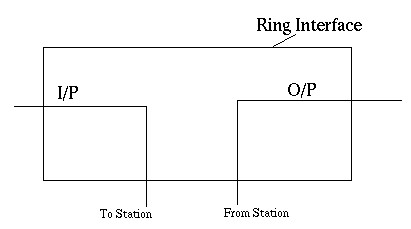
- By-pass Mode: In this mode reached when the node is down. Any data is just bypassed. There is no one-bit delay in this mode.
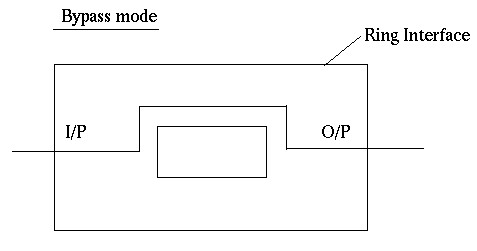
Token Ring Using Ring Concentrator
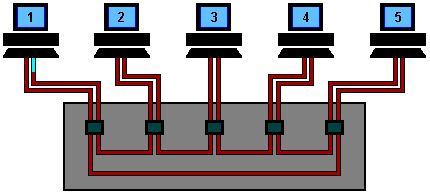
One problem with a ring network is that if the cable breaks somewhere,
the ring dies. This problem is elegantly addressed by using a ring
concentrator. A Token Ring concentrator simply changes the topology from
a physical ring to a star wired ring. But the network still remains a
ring logically. Physically, each station is connected to the ring
concentrator (wire center) by a cable containing at least two twisted
pairs, one for data to the station and one for data from the station.
The Token still circulates around the network and is still controlled in
the same manner, however, using a hub or a switch greatly improves
reliability because the hub can automatically bypass any ports that are
disconnected or have a cabling fault. This is done by having bypass
relays inside the concentrator that are energized by current from the
stations. If the ring breaks or station goes down, loss of the drive
current will release the relay and bypass the station. The ring can then
continue operation with the bad segment bypassed.
Who should remove the packet from the ring ?
There are 3 possibilities-
- The source itself removes the packet after one full round in the ring.
- The destination removes it after accepting it: This has two
potential problems. Firstly, the solution won't work for broadcast or
multicast, and secondly, there would be no way to acknowledge the sender
about the receipt of the packet.
- Have a specialized node only to discard packets: This is a bad
solution as the specialized node would know that the packet has been
received by the destination only when it receives the packet the second
time and by that time the packet may have actually made about one and half
(or almost two in the worst case) rounds in the ring.
Thus the first solution is adopted with the source itself removing the packet
from the ring after a full one round. With this scheme, broadcasting and
multicasting can be handled as well as the destination can acknowledge the
source about the receipt of the packet (or can tell the source about some
error).
Token Format
The token is the shortest frame transmitted (24 bit)
MSB (Most Significant
Bit) is always transmitted first - as opposed to Ethernet
SD = Starting Delimiter (1 Octet)
AC = Access Control (1 Octet)
ED =
Ending Delimiter (1 Octet)
Starting Delimiter Format:
J = Code Violation
K = Code Violation
Access Control Format:
T=Token
T = 0 for Token
T = 1 for Frame
When a station with a Frame to
transmit detects a token which has a priority equal to or less than the Frame to
be transmitted, it may change the token to a start-of-frame sequence and
transmit the Frame
P = PriorityPriority Bits indicate
tokens priority, and therefore, which stations are allowed to use it. Station can
transmit if its priority as at least as high as that of the token.
M
= Monitor The monitor bit is used to prevent a token whose priority is
greater than 0 or any frame from continuously circulating on the ring. If an
active monitor detects a frame or a high priority token with the monitor bit
equal to 1, the frame or token is aborted. This bit shall be transmitted as 0 in
all frame and tokens. The active monitor inspects and modifies this bit. All
other stations shall repeat this bit as received.
R = Reserved bits The reserved bits allow station with high
priority Frames to request that the next token be issued at the requested priority.
Ending Delimiter Format:
J = Code Violation
K = Code Violation
I = Intermediate Frame Bit
E = Error Detected Bit
Frame Format:
MSB (Most Significant Bit) is always transmitted first - as opposed to
Ethernet
| SD |
AC |
FC |
DA |
SA |
DATA |
CRC |
ED |
FS |
SD=Starting Delimiter(1 octet)
AC=Access Control(1 octet)
FC = Frame Control (1 Octet)
DA = Destination Address (2 or 6
Octets)
SA = Source Address (2 or 6 Octets)
DATA = Information 0 or more
octets up to 4027
CRC = Checksum(4 Octets)
ED = Ending Delimiter
(1 Octet)
FS=Frame Status
Starting Delimiter Format:
J = Code Violation
K = Code Violation
Access Control Format:
T=Token
T = “0” for Token,
T = “1” for Frame.
When a station with a Frame to transmit detects a token which has a priority
equal to or less than the Frame to be transmitted, it may change the token to a
start-of-frame sequence and transmit the Frame.
P = PriorityBits Priority Bits indicate tokens priority, and
therefore, which stations are allowed to use it. Station can transmit if its
priority as at least as high as that of the token.
M = MonitorThe monitor bit is used to prevent a token whose
priority is greater than 0 or any frame from continuously circulating on the
ring. if an active monitor detects a frame or a high priority token with the
monitor bit equal to 1, the frame or token is aborted. This bit shall be
transmitted as 0 in all frame and tokens. The active monitor inspects and
modifies this bit. All other stations shall repeat this bit as received.
R = Reserved bits the reserved bits allow station with high priority
Frames to request that the next token be issued at the requested priority
Frame Control Format:
| F |
F |
CONTROL BITS (6 BITS) |
FF= Type of Packet-Regular data packet or MAC layer packet
Control Bits= Used if the packet is for MAC layer protocol itself
Source and Destination Address Format:
The addresses can be of 2 bytes (local address) or 6 bytes (global address).
local address format:
| I/G (1 BIT) |
NODE ADDRESS (15 BITS) |
alternatively
| I/G (1 BIT) |
RING ADDRESS (7 BITS) |
NODE ADDRESS (8 BITS) |
The first bit specifies individual or group address.
universal (global) address format:
| I/G (1 BIT) |
L/U (1 BIT) |
RING ADDRESS (14 BITS) |
NODE ADDRESS (32 BITS) |
The first bit specifies individual or group address.
The second bit specifies
local or global (universal) address.
local group addresses (16 bits):
| I/G (1 BIT) |
T/B(1 BIT) |
GROUP ADDRESS (14 BITS) |
The first bit specifies an individual or group address.
The second bit specifies traditional or bit signature group address.
Traditional Group Address: 2Exp14 groups can be defined.
Bit Signature Group Address: 14 grtoups are defined. A host can be a
member of none or any number of them. For multicasting, those group bits are set
to which the packet should go. For broadcasting, all 14 bits are set. A host
receives a packet only if it is a member of a group whose corresponding bit is
set to 1.
universal group addresses (16 bits):
| I/G (1 BIT) |
RING NUMBER |
T/B (1 BIT) |
GROUP ADDRESS (14 BITS) |
The description is similar to as above.
Data Format:
No upper limit on amount of data as such, but it is limited by the token
holding time.
Checksum:
The source computes and sets this value. Destination too calculates this
value. If the two are different, it indicates an error, otherwise the data may
be correct.
Frame Status:
It contains the A and C bits.
A bit set to 1: destination recognized the
packet.
C bit set to 1: destination accepted the packet.
This
arrangement provides an automatic acknowledgement for each frame. The A and C
bits are present twice in the Frame Status to increase reliability in as much as
they are not covered by the checksum.
Ending Delimiter Format:
J = Code Violation
K = Code Violation
I = Intermediate Frame Bit
If
this bit is set to 1, it indicates that this packet is an intermediate part of a
bigger packet, the last packet would have this bit set to 0.
E = Error Detected Bit
This bit is set if any interface detects an error.
This concludes our description of the token ring frame format.
Token Ring Network (Contd...)
Phase Jitter Compensation :
In a token ring the source starts discarding all it's previously transmitted
bits as soon as they circumnavigate the ring and reach the source. Hence,
it's not desirable that while a token is being sent some bits of the token
which have already been sent become available at the incoming end of the
source. This behavior though is desirable in case of data packets which
ought to be drained from the ring once they have gone around the ring.
To achieve the aforesaid behavior with respect to tokens, we would like
the ring to hold at least 24 bits at a time. How do we ensure this?
Each node in a ring introduces a 1 bit delay. So, one approach might
be to set the minimum limit on the number of nodes in a ring as 24. But,
this is not a viable option. The actual solution is as follows. We
have one node in the ring designated as
"monitor". The monitor maintains
a 24 bits buffer with help of which it introduces a 24 bit delay. The catch
here is what if the clocks of nodes following the source are faster than
the source? In this case the 24 bit delay of the monitor would be less
than the 24 bit delay desired by the host. To avoid this situation the
monitor maintains 3 extra bits to compensate for the faster bits. The 3
extra bits suffice even if bits are 10 % faster. This compensation is called
Phase Jitter Compensation.
Handling multiple priority frames
Each node or packet has a priority level. We don't concern ourselves with
how this priority is decided. The first 3 bits of the Access Control byte
in the token are for priority and the last 3 are for reservation.
Initially the reservation bits are set to 000. When a node wants to
transmit a priority n frame, it must wait until it can capture a token
whose priority is less than or equal to n. Furthermore, when a data frame
goes by, a station can try to reserve the next token by writing the priority
of the frame it wants to send into the frame's Reservation bits. However,
if a higher priority has already been reserved there, the station cannot
make a reservation. When the current frame is finished, the next token
is generated at the priority that has been reserved.
A slight problem with the above reservation procedure is that the reservation
priority keeps on increasing. To solve this problem, the station raising
the priority remembers the reservation priority that it replaces and when
it is done it reduces the priority to the previous priority.
Note that in a token ring, low priority frames may starve.
Ring Maintenance
Each token ring has a monitor that oversees the ring. Among the monitor's
responsibilities are seeing that the token is not lost, taking action when
the ring breaks, cleaning the ring when garbled frames appear and watching
out for orphan frames. An orphan frame occurs when a station transmits
a short frame in it's entirety onto a long ring and then crashes
or is powered down before the frame can be removed. If nothing is done,
the frame circulates indefinitely.
- Detection of orphan frames: The monitor detects orphan frames by setting
the monitor bit in the Access Control byte whenever it passes through.
If an incoming frame has this bit set, something is wrong since the same
frame has passed the monitor twice. Evidently it was not removed by the
source, so the monitor drains it.
- Lost Tokens: The monitor has a timer that is set to the longest possible
tokenless interval : when each node transmits for the full token holding
time. If this timer goes off, the monitor drains the ring and issues a
fresh token.
- Garbled frames: The monitor can detect such frames by their invalid
format or checksum, drain the ring and issue a fresh token.
The token ring control frames for maintenance are:
|
Control field
|
Name
|
Meaning
|
| 00000000 |
Duplicate address test |
Test if two stations have the same address |
| 00000010 |
Beacon |
Used to locate breaks in the ring |
| 00000011 |
Claim token |
Attempt to become monitor |
| 00000100 |
Purge |
Reinitialize the ring |
| 00000101 |
Active monitor present |
Issued periodically by the monitor |
| 00000110 |
Standby monitor present |
Announces the presence of potential monitors |
The monitor periodically issues a message "Active Monitor Present" informing
all nodes of its presence. When this message is not received for a specific
time interval, the nodes detect a monitor failure.
Each node that believes it can function as a monitor broadcasts a "Standby
Monitor Present" message at regular intervals, indicating that it is ready
to take on the monitor's job.
Any node that detects failure of a monitor issues a "Claim" token. There
are 3 possible outcomes :
- If the issuing node gets back its own claim token, then it becomes
the monitor.
- If a packet different from a claim token is received, apparently
a wrong guess of monitor failure was made. In this case on receipt of our
own claim token, we discard it. Note that our claim token may have been
removed by some other node which has detected this error.
- If some other node has also issued a claim token, then the node with
the larger address becomes the monitor.
In order to resolve errors of duplicate addresses, whenever a node comes
up it sends a
"Duplicate Address Detection" message (with the destination
= source) across the network. If the address recognize bit has been
set on receipt of the message, the issuing node realizes a duplicate address
and goes to standby mode.
A node informs other nodes of removal of a packet from the ring through
a
"Purge" message.
One maintenance function that the monitor cannot handle is locating
breaks in the ring. If there is no activity detected in the ring (e.g.
Failure of monitor to issue the
Active Monitor Present token...) , the
usual procedures of sending a claim token are followed. If the claim token
itself is not received besides packets of any other kind, the node then
sends
"Beacons" at regular intervals until a message is received indicating
that the broken ring has been repaired.
Other Ring Networks
The problem with the token ring system is that large rings cause large
delays. It must be made possible for multiple packets to be in the ring
simultaneously. The following ring networks resolve this problem to some
extent :-
Slotted Ring :
In this system, the ring is slotted into a number of fixed size frames
which are continuously moving around the ring. This makes it necessary
that there be enough number of nodes (large ring size) to ensure that all
the bits can stay on the ring at the same time. The frame header contains
information as to whether the slots are empty or full. The usual disadvantages
of overhead/wastage associated with fixed size frames are present.
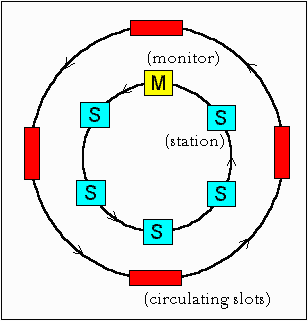 Register Insertion Rings :
Register Insertion Rings :
This is an improvement over slotted ring architecture. The
network interface
consists of two registers : a shift register and an output buffer.
At startup, the input pointer points to the rightmost bit position
in the input shift register .When a bit arrives it is in the rightmost
empty position (the one indicated by the input pointer). After the node
has detected that the frame is not addressed to it, the bits are
transmitted one at time (by shifting). As new bits come in, they are
inserted
at the position indicated by the pointer and then the contents are
shifted. Thus the pointer is not moved. Once the shift register has
pushed out the last bit of a frame, it checks to see if it has an output
frame waiting. In case yes, then it checks
that if the number of empty slots in the shift register is at least
equal
to the number of bits in the output frame. After this the output
connection
is switched to this second register and after the register has emptied
its contents, the output line is switched back to the shift register.
Thus,
no single node can hog the bandwidth. In a loaded system, a node can
transmit a k-bit frame only if it has saved up a k-bits of inter frame
gaps.
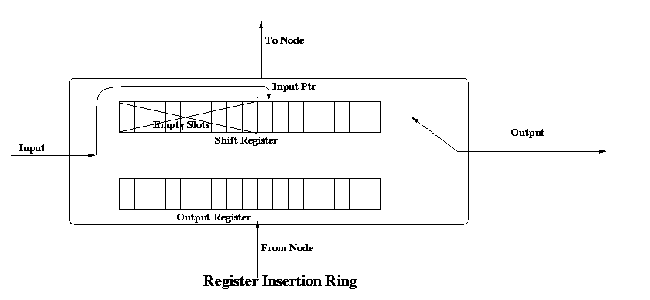
Two major disadvantages of this topology are complicated hardware and
difficulty in the detection of start/end of packets.
Contention Ring
The token ring has primarily two problems:
- On light loads, huge overhead is incurred for token passing.
- Nodes with low priority data may starve if there is always a node with high
priority data.
A contention ring attempts to address these problems. In a contention
ring, if there is no communication in the ring for a while, a sender
node will send its data immediately, followed by a token. If the token
comes back to the sender without any data packet in between, the sender
removes it from the ring. However under heavy load the behavior is that
of a normal token ring. In case a collision, each of the sending nodes
will remove the others' data packet from the ring, back off for a random
period of time and then resend their data.
IEEE 802.4: Token Bus Network
In this system, the nodes are physically connected as a bus, but
logically form a ring with tokens passed around to determine the turns
for sending. It has the robustness of the 802.3 broadcast cable and the
known worst case behavior of a ring. The structure of a token bus
network is as follows:
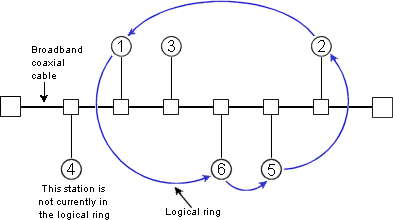
Frame Structure

A 802.4 frame has the following fields:
- Preamble: The Preamble is used to synchronize the receiver's clock.
- Starting Delimiter (SD) and End Delimiter (ED): The Starting Delimiter
and Ending Delimiter fields are used to mark frame boundaries. Both of them
contain analog encoding of symbols other than 1 or 0 so that they cannot occur
accidentally in the user data. Hence no length field is needed.
- Frame Control (FC): This field is used to distinguish data frames from control frames. For data
frames, it carries the frame's priority as well as a bit which the destination
can set as an acknowledgement. For control frames, the Frame Control field is
used to specify the frame type. The allowed types include token passing and
various ring maintenance frames.
- Destination and Source Address: The Destination and Source address fields may
be 2 bytes (for a local address) or 6 bytes (for a global address).
- Data: The Data
field carries the actual data and it may be 8182 bytes when 2 byte addresses are used and 8174 bytes for 6 byte
addresses.
- Checksum: A 4-byte checksum calculated for the data. Used in error detection.
Ring Maintenance:
Mechanism:
When the first node on the token bus comes up, it sends a
Claim_token packet
to initialize the ring. If more than one station send this packet at the same
time, there is a collision. Collision is resolved by a contention mechanism, in
which the contending nodes send random data for 1, 2, 3 and 4 units of time
depending on the first two bits of their address. The node sending data for the
longest time wins. If two nodes have the same first two bits in their addresses,
then contention is done again based on the next two bits of their address and so
on.
After the ring is set up, new nodes which are powered up may wish to join the
ring. For this a node sends
Solicit_successor_1 packets from time to time,
inviting bids from new nodes to join the ring. This packet contains the address
of the current node and its current successor, and asks for nodes in between
these two addresses to reply. If more than one nodes respond, there will be collision.
The node then sends a
Resolve_contention packet, and the contention is resolved
using a similar mechanism as described previously. Thus at a time only one node
gets to enter the ring. The last node in the ring will send a
Solicit_successor_2 packet containing the addresses of it and its successor.
This packet asks nodes not having addresses in between these two addresses to
respond.
A question arises that how frequently should a node send a Solicit_successor
packet? If it is sent too frequently, then overhead will be too high. Again if
it is sent too rarely, nodes will have to wait for a long time before joining
the ring. If the channel is not busy, a node will send a Solicit_successor
packet after a fixed number of token rotations. This number can be configured by
the network administrator. However if there is heavy traffic in the network,
then a node would defer the sending of bids for successors to join in.
There may be problems in the logical ring due to sudden failure of a node.
What happens when a node goes down along with the token? After passing the
token, a node, say node A, listens to the channel to see if its successor either
transmits the token or passes a frame. If neither happens, it resends a token.
Still if nothing happens, A sends a
Who_follows packet, containing the address
of the down node. The successor of the down node, say node C, will now respond
with a
Set_successor packet, containing its own address. This causes A to set
its successor node to C, and the logical ring is restored. However, if two
successive nodes go down suddenly, the ring will be dead and will have to be
built afresh, starting from a
Claim_token packet.
When a node wants to shutdown normally, it sends a
Set_successor packet to
its predecessor, naming its own successor. The ring then continues unbroken, and
the node goes out of the ring.
The various control frames used for ring maintenance are shown below:
Frame Control Field
|
Name
|
Meaning
|
| 00000000 |
Claim_token |
Claim token during ring maintenance |
| 00000001 |
Solicit_successor_1 |
Allow stations to enter the ring |
| 00000010 |
Solicit_successor_2 |
Allow stations to enter the ring |
| 00000011 |
Who_follows |
Recover from lost token |
| 00000100 |
Resolve_contention |
Used when multiple stations want to enter |
| 00001000 |
Token |
Pass the token |
| 00001100 |
Set_successor |
Allow the stations leave the ring |
Priority Scheme:
Token bus supports four distinct priority levels: 0, 2, 4 and 6.
0 is the lowest priority level and 6 the highest. The following times are
defined by the token bus:
- THT: Token Holding Time. A node holding the token can send priority 6 data
for a maximum of this amount of time.
- TRT_4: Token Rotation Time for class 4 data. This is the maximum time a
token can take to circulate and still allow transmission of class 4 data.
- TRT_2 and TRT_0: Similar to TRT_4.
When a station receives data, it proceeds in the following manner:
- It transmits priority 6 data for at most THT time, or as long as it has
data.
- Now if the time for the token to come back to it is less than TRT_4, it
will transmit priority 4 data, and for the amount of time allowed by TRT_4.
Therefore the maximum time for which it can send priority 4 data is= Actual TRT
- THT - TRT_4
- Similarly for priority 2 and priority 0 data.
This mechanism ensures that priority 6 data is always sent, making the system
suitable for real time data transmission. In fact this was one of the primary
aims in the design of token bus.
Image References:
- https://www.cis.strath.ac.uk/teaching/ug/classes/52.354/Images/SlottedRing.gif
- http://www.lkn.ei.tum.de/lehre/mmprog/mac/protocols/token-bus/pics/bus1.gif
- http://www.acerimmeronline.com/networks/images/token_bus_frame.gif
if u like the post just say thank u in comment box.









No comments:
Post a Comment
its cool